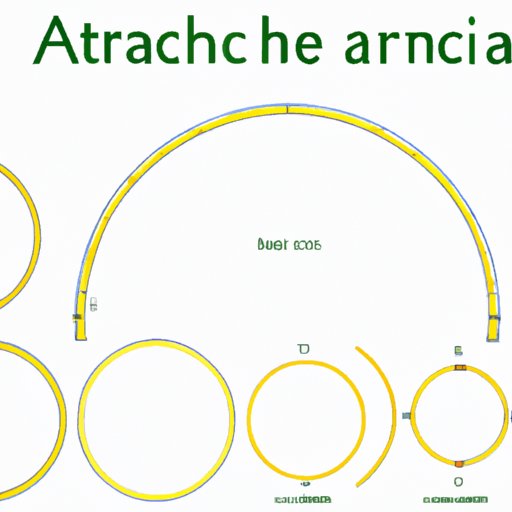
I. Introduction
Circles are among the most basic and prevalent shapes in mathematics. One of the fundamental concepts associated with circles is the arc length. Understanding arc length is vital in various disciplines, including physical sciences, engineering, and architecture. Arc length can be used to determine the position of an object in motion, measure the perimeter of a sector, and identify the length of a curved line. Therefore, in this article, we will explore how to find arc length of a circle, emphasizing the formulas, approaches, and tips to master the concept.
II. Basics of Arc Length Calculation in a Circle
Arc length is the distance along a circle’s edge between two points, measured in linear units. The arc length symbol is “s,” and it is denoted in units of length, such as inches or meters. For a given circle, arc length s is related to the circle’s circumference C and the measure of the central angle θ (in radians) as follows:
Where:
s: arc length
θ: central angle (in radians)
C: circumference of the circle
The central angle θ is the angle formed by two radii of a circle that intersect at the center. One full revolution, or 360°, is equal to 2π radians. Therefore, we can convert degrees to radians by multiplying by π/180 or use a calculator’s degree-to-radian conversion function.
III. Finding Arc Length Using Central Angle
The formula for finding arc length using the central angle θ is:
Where:
r: radius of the circle
Therefore, the arc length s is equal to the central angle θ multiplied by the radius r. This equation is applicable when the angle θ is measured in radians.
Example problem: Find the arc length of a circle with a radius of 10 inches and a central angle of 60°.
First, convert 60° to radians by multiplying 60 by π/180, which gives θ = π/3 rad. Then, substitute the values of r and θ into the formula:
Therefore, the arc length of the circle is approximately 10.47 inches.
IV. Formula to Find Arc Length in a Circle
The arc length formula expressed as a function of the circle’s diameter and central angle θ is:
Where:
d: diameter of the circle
This equation is more general than the previous formula and applies to both degrees and radians. To use this equation, the measure of the central angle must be in the same unit as the formula’s denominator.
To obtain the arc length for a given measure of the central angle, the following formula can be used:
Where:
r: radius of the circle
θ: central angle (in radians)
This equation is useful when the diameter of the circle can be measured more accurately than the radius.
Example problem: Find the arc length of a circle with a diameter of 20 meters and a central angle of 135°.
First, convert 135° to radians by multiplying 135 by π/180, which gives θ = 3π/4 rad. Then, use the formula:
Therefore, the arc length of the circle is approximately 7.85 meters.
V. Mastering the Concept of Arc Length in a Circle- A Beginner’s Guide
As with any mathematical concept, understanding arc length requires practice, patience, and knowledge of the basics. Here are some common misconceptions and tips to help you master the concept.
Common misconceptions and mistakes:
- Confusing arc length with arc angle: arc angle is the measure of the central angle, while arc length is the distance traveled along the arc.
- Assuming that arc length is equal to the chord length: a chord is a line drawn between two points on the circumference and is not equivalent to an arc length.
Tips for understanding and visualizing the concept:
- Use a compass and ruler to draw circles and their properties.
- Relate arc length to real-life scenarios, such as a vehicle traveling along a circular track.
- Practice solving problems involving different arc lengths, central angles, and radii.
VI. Simplifying the Process of Finding Arc Length in a Circle – Tips and Tricks
There are many useful shortcuts and tricks that can be helpful in calculating arc length.
Useful shortcuts for calculations:
- When using the formula
, it is sometimes easier to convert degrees to radians first, perform the multiplication, and then convert the answer back to degrees.
- When using the formula
, it is useful to reduce the fraction in the equation before plugging in the values.
- For large central angles, it may be simpler to divide the circle into smaller sectors and add their arc lengths.
Practical applications of arc length:
- Determining the distance traveled by a rotating object
- Measuring the perimeter of a field or a circular painting
- Calculating the circumference of a round playground, gyroscope or a tire
VII. Different Methods to Find Arc Length in a Circle – A Comparative Study
There are two primary methods to calculate arc length: using central angle and using the formula. Each method has its advantages and disadvantages.
Comparison between the formula method and central angle method:
- The formula method is more general and applies to both degrees and radians, while the central angle method is only applicable to radians.
- The central angle method is more straightforward when the angle is given in radians, while the formula method is simpler when using degrees.
Both approaches can yield the same result; the choice depends on the given situation and personal preference.
VIII. Conclusion
Arc length is a vital concept that is frequently utilized in various fields to measure distances and quantities. Understanding arc length requires knowledge of basic concepts such as the circle’s circumference, radius, and central angle. The two primary methods to calculate arc length are using central angle or using the formula. Tips and tricks such as converting units, dividing sectors, and visualizing the concept can aid in mastering the concept. By practicing and developing proficiency in calculating arc length, individuals can apply this concept in numerous practical scenarios.




